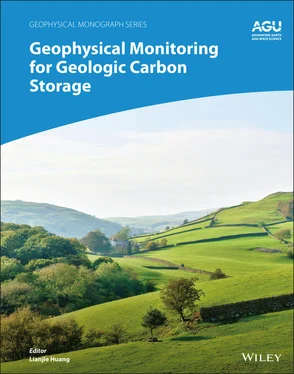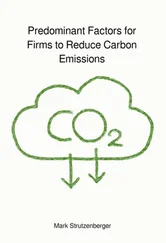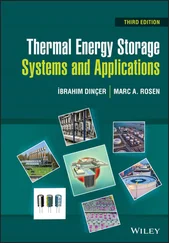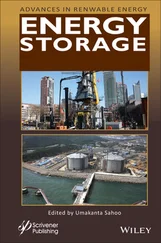Geophysical Monitoring for Geologic Carbon Storage
Здесь есть возможность читать онлайн «Geophysical Monitoring for Geologic Carbon Storage» — ознакомительный отрывок электронной книги совершенно бесплатно, а после прочтения отрывка купить полную версию. В некоторых случаях можно слушать аудио, скачать через торрент в формате fb2 и присутствует краткое содержание. Жанр: unrecognised, на английском языке. Описание произведения, (предисловие) а так же отзывы посетителей доступны на портале библиотеки ЛибКат.
- Название:Geophysical Monitoring for Geologic Carbon Storage
- Автор:
- Жанр:
- Год:неизвестен
- ISBN:нет данных
- Рейтинг книги:4 / 5. Голосов: 1
-
Избранное:Добавить в избранное
- Отзывы:
-
Ваша оценка:
- 80
- 1
- 2
- 3
- 4
- 5
Geophysical Monitoring for Geologic Carbon Storage: краткое содержание, описание и аннотация
Предлагаем к чтению аннотацию, описание, краткое содержание или предисловие (зависит от того, что написал сам автор книги «Geophysical Monitoring for Geologic Carbon Storage»). Если вы не нашли необходимую информацию о книге — напишите в комментариях, мы постараемся отыскать её.
Geophysical Monitoring for Geologic Carbon Storage
Volume highlights include: Geophysical Monitoring for Geologic Carbon Storage
The American Geophysical Union promotes discovery in Earth and space science for the benefit of humanity. Its publications disseminate scientific knowledge and provide resources for researchers, students, and professionals.
Geophysical Monitoring for Geologic Carbon Storage — читать онлайн ознакомительный отрывок
Ниже представлен текст книги, разбитый по страницам. Система сохранения места последней прочитанной страницы, позволяет с удобством читать онлайн бесплатно книгу «Geophysical Monitoring for Geologic Carbon Storage», без необходимости каждый раз заново искать на чём Вы остановились. Поставьте закладку, и сможете в любой момент перейти на страницу, на которой закончили чтение.
Интервал:
Закладка:
3 Chapter 8Table 8.1 Inversion results of time‐lapse VSP source offsets obtained using...
4 Chapter 12Table 12.1 Main parameters of the optimizer. They could be defined globally...
5 Chapter 14Table 14.1 Main parameters used in the faulted reservoir simulation
6 Chapter 15Table 15.1 Values of porosity and Archie’s coefficients a and m for various...Table 15.2 Electrode arraysTable 15.3 Percentage change from half‐space response caused by 50 m thick ...
7 Chapter 16Table 16.1 Resistivity of some common rocks
8 Chapter 17Table 17.1 Input parameters for generation of  Table 17.2 Input parameters for generation of
Table 17.2 Input parameters for generation of 
9 Chapter 19Table 19.1 Stratigraphy at the IBDP siteTable 19.2 Description of wells at IBDP
10 Chapter 21Table 21.1 Tool selection criteria and deployment typeTable 21.2 Summary of tool response and lessons learned
11 Chapter 22Table 22.1 Utsira sandstone and Nordland shale propertiesTable 22.2 Brine and CO 2properties
12 Chapter 23Table 23.1 Summary of geophysical monitoring methods discussed in chapter 2...
13 Chapter 24Table 24.1 Advantages and limitations of various geophysical monitoring tec...
List of Illustrations
1 Chapter 2 Figure 2.1 A schematic showing the relationship between ground displacement ... Figure 2.2 Example of motion decomposition combining ascending and descendin... Figure 2.3 Range changes above the carbon storage site at In Salah, Algeria,... Figure 2.4 (a) Onset time of the most rapid change in reservoir volume. The ... Figure 2.5 (a) Detailed view of range change above well KB‐502 following 1,0... Figure 2.6 (a) Vertical displacements above well KB‐501, derived from X‐band... Figure 2.7 Distribution of total aperture change (effective fracture zone op... Figure 2.8 Calculated vertical displacement based upon the distribution of a... Figure 2.9 (a) Location of the Aquistore storage site in Saskatchewan, Canad... Figure 2.10 (a) RADARSAT‐2 Spotlight 12 SAR intensity image acquired on 23 A... Figure 2.11 Observed (a) vertical and (b) east‐west horizontal deformation r... Figure 2.12 Two components of displacement associated with point P2 from Fig... Figure 2.13 (a) Distribution of scatterers in the region surrounding the inj... Figure 2.14 Average range change from the 21 artificial reflectors installed... Figure 2.15 Time series of two measurement points in the vicinity of the inj...
2 Chapter 3 Figure 3.1 The CO 2produced from several anthropogenic and natural processes... Figure 3.2 A FMS instrument produces sidebands (ω c± ω m) shifted from the ca... Figure 3.3 The in situ FMS instrument built at Los Alamos National Laborator... Figure 3.4 An example of (a) Voigt absorption profile and (b) the correspond... Figure 3.5 (a) A relatively sharp Voigt absorption profile and (b) the corre... Figure 3.6 Least‐squares fitting of FMS spectra. “Simulated” FMS data (the b... Figure 3.7 The derivative shaped FMS spectrum recorded for several (a) 12C 16 Figure 3.8 A demonstration of the FMS accuracy and sensitivity where calibra... Figure 3.9 A comparison of the FMS stable isotope concentrations measured in... Figure 3.10 The remote FMS instrument was deployed to the ZERT controlled‐re...
3 Chapter 4 Figure 4.1 The procedure for optimal design of seismic network for microseis... Figure 4.2 The location of the Kimberlina CCUS (carbon capture, utilization,... Figure 4.3 P‐wave velocity model for the Kimberlina site. Figure 4.4 The true locations of microseismic events (black dots) used in th... Figure 4.5 The initial (blue dots) and relocated (red dots) microseismic eve... Figure 4.6 The initial (blue dots) and relocated (red dots) microseismic eve... Figure 4.7 Event location accuracy versus the total number of seismic statio... Figure 4.8 (a,b) Two examples of the irregularly distributed 25 seismic stat... Figure 4.9 Comparison between mean event location accuracy for regularly spa... Figure 4.10 The true locations of microseismic events (black dots) used for ... Figure 4.11 The initial (blue dots) and relocated (red dots) microseismic ev... Figure 4.12 Event location accuracy versus the total number of geophones for...
4 Chapter 5 Figure 5.1 Split‐Hopkinson Resonant Bar. A small (typically 2.5 cm–10 cm lon... Figure 5.2 Photograph of an on‐going scCO 2injection experiment. The experim... Figure 5.3 Examples of experimentally measured frequency response functions ... Figure 5.4 Young's modulus E and shear modulus G and their attenuations dete... Figure 5.5 Young's modulus and related attenuations determined from SHRB tes... Figure 5.6 Shear modulus and related attenuations determined from SHRB tests... Figure 5.7 X‐ray CT images of scCO 2invasion into intact and fractured sands... Figure 5.8 Fluid substitution modeling of the impact of fracture compliance ... Figure 5.9 Young's modulus E and its related attenuation a Ecompared with th... Figure 5.10 Comparison between the scCO 2saturations in Frac IIb sample with... Figure 5.11 Changes in the uniaxial Skempton coefficients B/3 and B F/3 durin...
5 Chapter 6 Figure 6.1 (a) Ultrasonic waveform recorded passing through the aluminum ref... Figure 6.2 (a) Project work‐flow diagram highlighting the rock physics exper... Figure 6.3 (a) V p‐V srelationship for all rhyolite core data; (b) temperatur...Figure 6.4 (a) V pvs effective pressure for various temperature experiments ...Figure 6.5 (a) V pvs effective pressure for various temperature experiments ...Figure 6.6 (a) Q pvs effective pressure for the low porosity rhyolite core; ...Figure 6.7 (a) Q pvs effective pressure for the high porosity rhyolite core;...Figure 6.8 (a) λ ρvs μ ρmoduli and (b) Young's modulus versus Pois...Figure 6.9 (a) and (c) Interpretation Young's modulus vs Poisson's ratio, an...Figure 6.10 Fluid saturation P‐wave velocity measurements for the (a) low po...Figure 6.11 (a) V P‐V S1data for the fluid saturation experiments for both th...Figure 6.12 Attenuation results for the fluid substitution experiments for t...Figure 6.13 Fourth generation medical imaging resolution CT scan of low poro...Figure 6.14 λ ρ‐μ ρdata for all fluid saturation experiments for bo...Figure 6.15 Poisson's ratio–Young's modulus and λ ρ‐μ ρdata for the...
6 Chapter 7Figure 7.1 Illustrations of (a) incident elastic waves, (b) elastic‐wave ref...Figure 7.2 A 2D slice of the elastic SEG‐EAGE salt model: (a) P‐wave velocit...Figure 7.3 Distributions of elastic‐wave energies (E Pand E S), and elast...Figure 7.4 Normalized elastic‐wave energies and elastic‐wave sensitivity ene...Figure 7.5 Distributions of elastic‐wave energies (E Pand E S), and elast...Figure 7.6 Normalized elastic‐wave energies and elastic‐wave sensitivity ene...Figure 7.7 The 2D layered elastic models with a fault zone. The width of the...Figure 7.8 Spatial distribution of P‐wave sensitivity energy for the normal ...Figure 7.9 Spatial distribution of S‐wave sensitivity energy for the normal ...Figure 7.10 Normalized (a) P‐wave sensitivity energy and (b) S‐wave sensitiv...Figure 7.11 Spatial distribution of P‐wave sensitivity energy with respect t...Figure 7.12 Spatial distribution of S‐wave sensitivity energy for the revers...Figure 7.13 Normalized (a) P‐wave sensitivity energy and (b) S‐wave sensitiv...Figure 7.14 Spatial distribution of P‐wave sensitivity energy for the normal...Figure 7.15 Spatial distribution of S‐wave sensitivity energy for the normal...Figure 7.16 Normalized elastic‐wave sensitivity energies at the surface for ...Figure 7.17 Spatial distribution of P‐wave sensitivity energy for the revers...Figure 7.18 Spatial distribution of S‐wave sensitivity energy for the revers...Figure 7.19 Normalized elastic‐wave sensitivity energies at the surface for ...Figure 7.20 The modified Hess anisotropic model: Panels (a)–(d) show the ela...Figure 7.21 Wavefield snapshots of the x 3‐component of the elastic displacem...Figure 7.22 Spatial distributions of qP‐wave (a, b, c, d) and qS‐wave (e, f,...Figure 7.23 Spatial distributions of qP‐wave (a, b, c, d) and qS‐wave (e, f,...Figure 7.24 The normalized qP‐wave sensitivity energies with respect to the ...Figure 7.25 The qP‐wave (a, b) and qS‐wave (c, d) sensitivity energies with ...
Читать дальшеИнтервал:
Закладка:
Похожие книги на «Geophysical Monitoring for Geologic Carbon Storage»
Представляем Вашему вниманию похожие книги на «Geophysical Monitoring for Geologic Carbon Storage» списком для выбора. Мы отобрали схожую по названию и смыслу литературу в надежде предоставить читателям больше вариантов отыскать новые, интересные, ещё непрочитанные произведения.
Обсуждение, отзывы о книге «Geophysical Monitoring for Geologic Carbon Storage» и просто собственные мнения читателей. Оставьте ваши комментарии, напишите, что Вы думаете о произведении, его смысле или главных героях. Укажите что конкретно понравилось, а что нет, и почему Вы так считаете.












